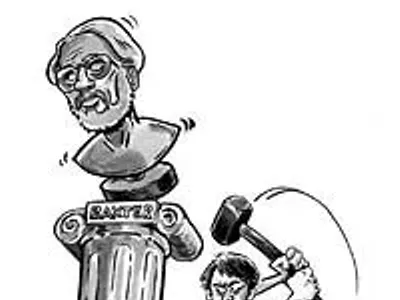You have to leave Detroit to get discovered. It is a saying you hear a lot from artists who’ve left Detroit to get discovered. But perhaps that’s unfair. You have to leave just about any city for New York or Los Angeles to get discovered. They just aren’t discovering people as much in, say, St. Paul, Minn.
For the visual arts scene, New York may be losing its edge as No. 1, as some Detroit artists are ending up in Los Angeles. Most go to get famous, but also take on teaching, like graphic designer Ed Fella. And others move there to do high-paying contract work, like sculptor Eddy Sykes. Former Detroit artist and architect Christopher Mercier chose Los Angeles because, as the city with a Cubist-designed Kentucky Fried Chicken, it seemed the natural choice.
“L.A. is less judgmental about the crossing of genres,” says Sykes, whose sculptures — some kinetic, some static, some mobile — speak of an artist who’s up for anything. For about a year in the late ’90s, Sykes ran the Big Biscuit gallery in Detroit’s Eastern Market. He describes his art as a product of Detroit, though he says it is also antagonistic to the darker work that’s popular in the Motor City, and some local folks didn’t like that. Case in point: Sykes was commissioned by Wayne State University to design a memorial for Professor Andrzej W. Olbrot, who’d been gunned down. The 13-foot stainless steel piece that sits outside the Engineering Building (on Anthony Wayne Drive at West Warren) was deemed too shiny. Against his wishes, it was sanded.
The home and studio Sykes leased a few months ago with collaborator Michael McDermott is a few miles east of Hollywood, on the outskirts of the hilly neighborhoods of Silver Lake and Echo Park, an area littered with taco stands and body shops. Sykes moved there from Oakland, Calif., to build an elaborate sculptural staircase commissioned for a private residence. Its individual landings are planes of translucent blue epoxy molded in the shape of bird’s eggs. “They’ll be walking on eggshells,” Sykes sheepishly observes. This structure epitomizes Sykes’ attraction to Los Angeles: Folks do some crazy decorating in their homes, and the city’s various entertainment industries offer easy access to material.
Sykes, 34, still has the perma-grin of a newcomer. He calls Los Angeles a “barbecue culture”: inviting and gracious, as long as you don’t come too hungry.
It is the paradoxical nature of this large and sprawling West Coast city that a person can have just the opposite experience. Former Detroiter Sam Pope has been in Los Angeles for four years and still calls it a tough nut to crack. Pope, 52, currently makes a living as a freelance graphic designer and lives in an open, spacious, bi-level studio and apartment in Long Beach, about 30 minutes from central Los Angeles. An alumnus of Wayne State University, he eventually became involved in Detroit’s art scene, showing occasionally but making his imprint mostly as a volunteer, moving art at the Susanne Hilberry Gallery, teaching at Your Heritage House and assisting performance artists, such as Nelson Smith.
As for Los Angeles’ gallery scene, he shows his Detroit colors by not mincing words: “The work I’ve seen is so horrible. I can’t even look at it. It makes me sick.” He says the art ranges from superficial to intellectual and conceptual, whereas Detroit’s is personal and emotional — it has “a lot of soul.”
Even so, some Detroit artists venture to the left coast for freedom and opportunity to experiment. This was the deciding factor for former Detroit artist and architect Mercier, 41, who now owns and runs his own architecture studio, the Christopher Mercier Studio (Form Environment Research), in Inglewood. Before setting off permanently from Detroit, Mercier studied in Milan, Italy, with Daniel Libeskind, the architect now running the Ground Zero Project in New York. Mercier says he left Detroit because it didn’t have a viable architecture scene and he chose Los Angeles over New York for a couple reasons, the most obvious being it had more room to build.
Los Angeles also seems like a natural environment to Ed Fella, a longtime graphic designer who worked for various Detroit galleries and is now a graphic design teacher at California Institute of the Arts. Fella, a 67-year-old artist and Cranbrook Academy of Art alumnus, helped revolutionize graphic design in the 1980s. The design language he helped create — familiar to anyone who’s a devotee of indie zines — squeezes every font imaginable into a few pages. Though studied and careful, Fella’s shape-shifting characters and numerals snake behind margins and fall down pages. Fella thinks his style is a natural product of Detroit, “the city of the vernacular.” His work is partly an amassing of the vernacular lettering found on handmade signage. Although his heart is in Detroit, he feels he had to move to Los Angeles to make it in the pages of magazines and art books. But the landscape also seems geographically perfect. Like Detroit, the Los Angeles landscape seems to have a personality that despises convention and uniformity, and, like a lot of Fella’s work, risks incoherence. Colonial frame homes are built proudly next to Spanish villas. There is an overabundance of ugliness bumping together in just the right way to be beautiful.
For 10 years, Lucy Bates, Ed Fella’s wife, was a volunteer at the Detroit Artists Market. Then she moved with her husband to Los Angeles. (She is still an honorary board member at DAM). She now serves as photo editor of his books. Bates, 57, lauds the work of Detroit artists but thinks the Motor City needs stronger institutions, as well as writers who will record the history of its art. She also laments that Detroit artists have little space to show in. In Los Angeles, artist covens near the Santa Monica beaches, such as Bergamot Station gallery center, are convenient areas to view the city’s art and make connections in the field. Still, while it may be easier to make a name in Los Angeles, Bates thinks Detroit artists are lucky to be sheltered from the trend-chasing that dominates the West Coast.
“I think there are plenty of Midwestern artists whose work would look better on the walls.” What keeps Detroit’s close-knit scene from achieving what disconnected artists in other cities do? It’s not soul, it’s infrastructure.
Wayne Melton is a freelance writer who lives in Los Angeles. Send comments to letters@metrotimes.com





